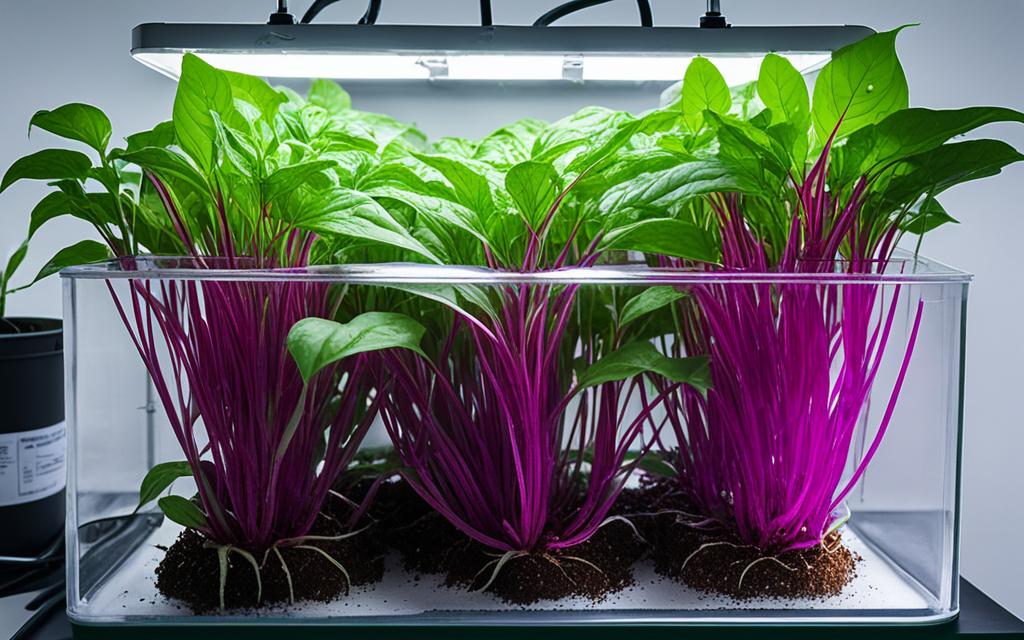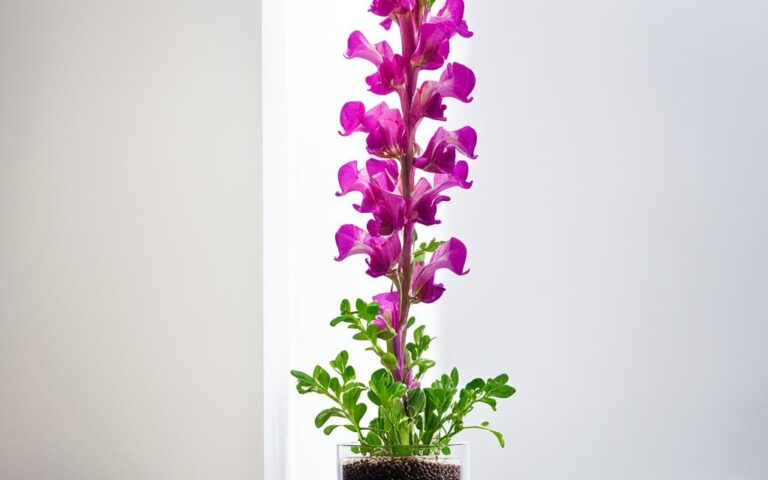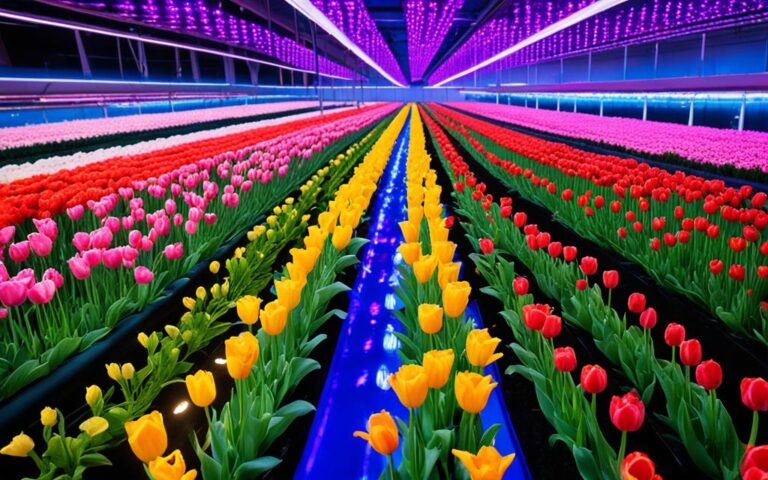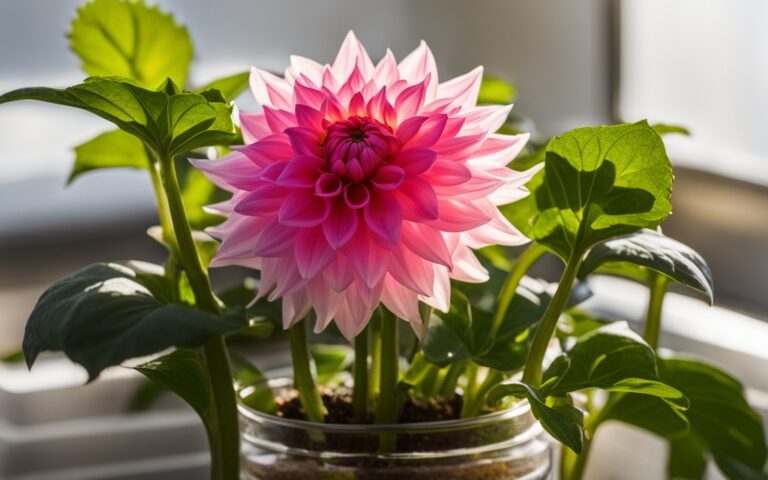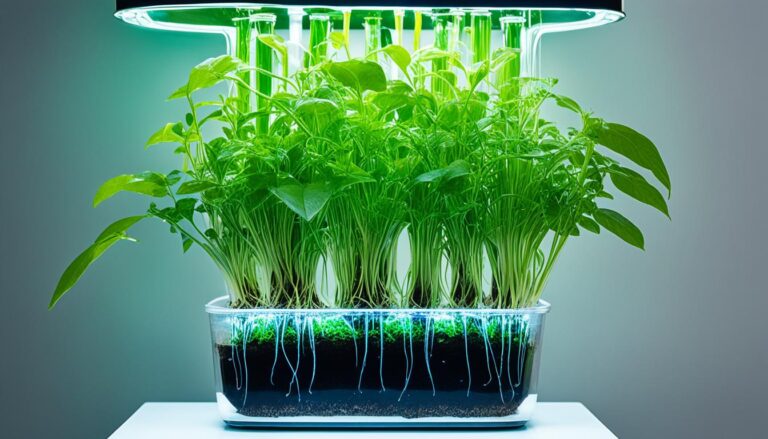Hydroponic Amaranth: Grow Lush Greens at Home
Did you know that 10 square feet of hydroponic space can produce up to 4 pounds of amaranth greens each month? This microgreen is a powerhouse, full of vitamins, minerals, and protein. It can be harvested in just 10 days, offering a quick and sustainable way to get fresh, tasty greens for your kitchen.
Hydroponic amaranth has many benefits over growing in soil. You can control the nutrients, pH, and conditions perfectly. This means you can grow amaranth greens that are full of flavor and nutrients. It’s great for both experienced gardeners and beginners looking to try something new.
Key Takeaways
- Hydroponic amaranth can be harvested in just 10 days, providing a quick and sustainable source of fresh greens.
- Hydroponic systems allow for precise control over nutrient delivery, pH, and growing conditions, leading to lush, vibrant amaranth greens.
- Amaranth is a nutrient-rich microgreen that is packed with essential vitamins, minerals, and protein.
- Growing amaranth hydroponically can be a rewarding experience for both seasoned gardeners and beginners.
- Hydroponic amaranth cultivation offers numerous advantages over traditional soil-based methods.
Introduction to Hydroponic Amaranth
Hydroponic amaranth is a unique crop that grows without soil. It uses a special way to feed the plants with nutrients. This method helps plants grow big and produce a lot of food. By learning about hydroponic amaranth, gardeners can grow a plant that is both healthy and tasty.
What is Hydroponic Amaranth?
Hydroponic amaranth means growing amaranth plants in water instead of soil. The plants’ roots get nutrients from a special solution in the water. This way, growers can control the nutrients and conditions for the plants perfectly.
Benefits of Growing Hydroponic Amaranth
Benefits of growing hydroponic amaranth include:
- Higher Nutrient Content: Hydroponic systems give plants exactly what they need, making the produce more nutritious.
- Faster Maturity: Plants grow faster without needing a big root system, leading to quicker harvests.
- Year-Round Cultivation: You can grow what is hydroponic amaranth all year, even in small spaces like apartments.
Whether you garden at home or on a large scale, hydroponic amaranth offers many benefits. It’s a great way to grow a nutritious and versatile crop.
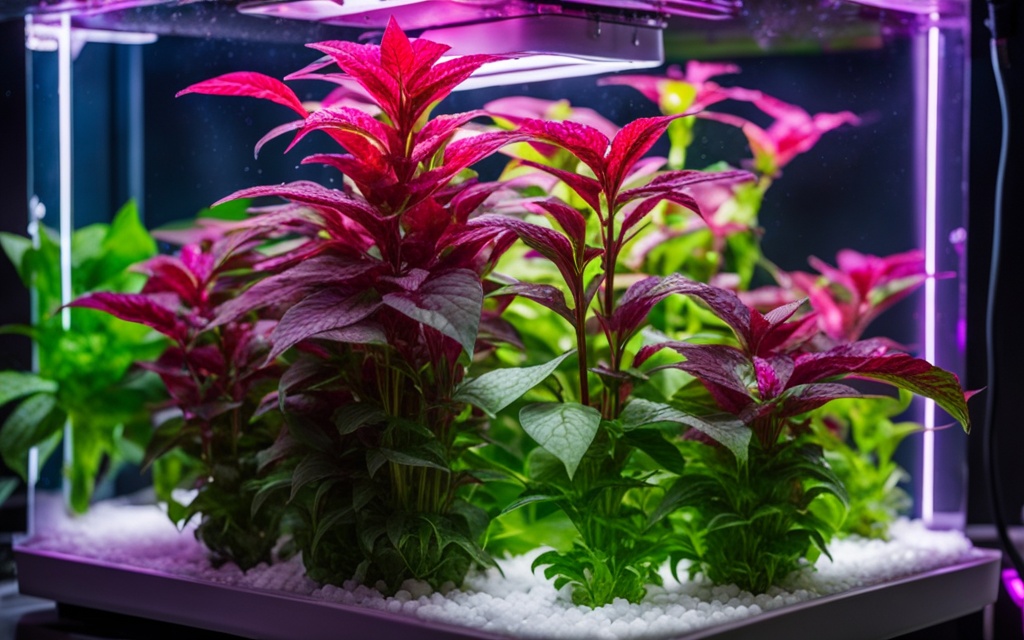
“Hydroponic amaranth is a game-changer for those looking to grow their own nutritious greens, even in limited spaces. By harnessing the power of this innovative growing method, you can enjoy a continuous supply of fresh, flavorful amaranth year-round.”
Selecting the Right Varieties
Choosing the right hydroponic amaranth varieties is key for success. Some top picks include:
Burgundy Amaranth
Burgundy Amaranth stands out with its deep burgundy color and a mild mustardy taste. It grows well in hydroponics and is perfect for home gardens. It adds a pop of color and flavor indoors.
Hot Biscuits Amaranth
Hot Biscuits Amaranth has green leaves and caramel-colored seed plumes. It brings a unique sweet flavor to hydroponic gardens. It’s ideal for those wanting a sweet addition to their plants.
Love-Lies-Bleeding Amaranth
Love-Lies-Bleeding Amaranth has green and maroon leaves for a bold look. It’s an heirloom type that’s both flavorful and visually striking. It’s a favorite for adding depth to indoor gardens.
These three varieties – burgundy amaranth, hot biscuits amaranth, and love-lies-bleeding amaranth – excel in hydroponics. They are great for home growers aiming for lush, tasty amaranth plants.
Setting Up Your Hydroponic System
Creating a successful hydroponic system for amaranth needs the right equipment and growing conditions. Whether you’re growing microgreens or full-size plants, it’s easy to set up. You can adjust it to fit your space and budget.
To set up a hydroponic system for amaranth, pick the right containers, growing media, and how you’ll deliver water and nutrients. Use shallow trays with drainage holes for microgreens. For full-size plants, consider deep water culture or ebb and flow systems.
A mix of one part potting soil and one part rehydrated coco coir, or a quality seed starting mix, is great for amaranth. Make sure the growing medium drains well and has good air flow for healthy plants.
| Hydroponic System Type | Suitable for Amaranth | Key Considerations |
|---|---|---|
| Shallow Trays | Microgreens | Drainage holes, growing medium |
| Deep Water Culture | Full-size Plants | Nutrient solution, air pump |
| Ebb and Flow | Full-size Plants | Flooding and draining cycles |
If you’re growing indoors, get grow lights for your amaranth. They provide the consistent, bright light needed for growth. With the right setup and conditions, you can have a lot of fresh, nutritious amaranth at home.
“Hydroponic systems offer a convenient and efficient way to grow nutrient-rich amaranth, even in limited indoor spaces.”
Nutrient Management and Fertilizer
Getting the nutrients right is crucial for hydroponic amaranth to grow well and produce a lot. These greens need a balance of nutrients to do their best. Knowing what hydroponic amaranth needs and its ideal pH is important for a good harvest.
Essential Nutrients for Hydroponic Amaranth
Amaranth plants in hydroponics need certain nutrients to stay healthy. These include:
- Nitrogen (N) for healthy leaf growth
- Phosphorus (P) for strong root development
- Potassium (K) for overall plant vigor and disease resistance
- Calcium, magnesium, and various micronutrients for optimal nutrient uptake and plant functions
pH and TDS/EC Requirements
Keeping the right pH and TDS/EC levels in the nutrient solution is key for hydroponic amaranth. The ideal pH is between 6.0 and 6.5 for these greens. This lets them absorb nutrients well. Checking and adjusting the TDS/EC levels keeps the nutrients balanced for healthy growth.
A good fertilizer made for hydroponic systems gives the right nutrients for hydroponic amaranth plants.
Light and Temperature Requirements
Getting the right balance of light and temperature is key for growing healthy hydroponic amaranth plants. Amaranth can grow in various lighting conditions but does best with consistent, enough light.
Grow Light Options for Hydroponic Amaranth
Supplemental grow lights are a must for hydroponic amaranth to get enough light. LED and fluorescent grow lights are great choices. They give the right kind of light for strong leaves and stems.
When picking grow lights for your hydroponic amaranth, look for these features:
- Full-spectrum light with a balanced mix of red, blue, and white light
- At least 6,000 to 8,000 lux (lumens per square meter) of light
- A 12 to 16 hour light cycle each day
Keeping the right hydroponic amaranth temperature is also key for growth. The best temperature for hydroponic amaranth is between 65°F and 75°F (18°C to 24°C).
| Lighting Requirement | Temperature Requirement |
|---|---|
| 6,000 to 8,000 lux light intensity | 65°F to 75°F (18°C to 24°C) |
| 12 to 16 hours of light per day | Consistent, stable temperature |
| Full-spectrum LED or fluorescent grow lights | Avoid temperature fluctuations |
By giving your hydroponic amaranth the right hydroponic amaranth light requirements and temperature, you can make a perfect growing space. Your plants will thrive.
Germination and Seedling Care
Growing hydroponic amaranth can start from seeds or transplants. Each way has its own benefits. The choice depends on what you prefer and your growing space.
Starting from Seeds
Starting with hydroponic amaranth seeds lets you control the environment. You can adjust the soil, moisture, and light for the seedlings. This ensures the best germination and early growth, leading to a strong and healthy crop.
Using Transplants
Or, you can grow hydroponic amaranth from transplants. This gives your plants a head start since they’ve already germinated and developed roots. It’s a good choice for gardeners who want to avoid the germination step and go straight to growing.
Whether from seeds or transplants, hydroponic amaranth needs to be planted in a shallow container with a good growing medium. This could be a soilless mix or coco coir. Keep the medium moist but not too wet during germination and early growth. Proper hydroponic amaranth seedling care, including the right light and temperature, is key for a healthy plant.
| Germination and Seedling Care | Starting from Seeds | Using Transplants |
|---|---|---|
| Planting Medium | Fine-textured soilless mix or coco coir | Fine-textured soilless mix or coco coir |
| Moisture Level | Consistently moist, but not waterlogged | Consistently moist, but not waterlogged |
| Lighting and Temperature | Provide optimal lighting and temperature conditions | Provide optimal lighting and temperature conditions |
| Advantages | Complete control over growing environment | Head start on growth, skip germination process |
Knowing how to handle hydroponic amaranth germination and seedling care, whether from seeds or transplants, sets your crop up for success. This way, you can enjoy a great harvest.
Hydroponic Amaranth: Growing and Maintenance
To grow hydroponic amaranth, you need to take good care of it. Start by making sure the seedlings get the right nutrients. Adjust the pH and EC levels often to keep the plants healthy.
It’s also important to keep the right amount of light, temperature, and humidity. These conditions help the plants grow well and produce a lot.
Checking your plants often is key to catching pests or diseases early. Quick action is necessary to keep the amaranth healthy. By following best practices for growing hydroponic amaranth and maintaining hydroponic amaranth, you can get a big harvest of these healthy greens.
Make sure the plants get the right amount of nutrients. Check and adjust the levels of important nutrients often. This ensures the plants grow strong and healthy.
- Regularly test and adjust the pH and EC (electrical conductivity) levels to maintain the ideal range for hydroponic amaranth
- Provide the appropriate light spectrum and intensity to support photosynthesis and healthy leaf growth
- Monitor temperature and humidity levels, making adjustments as needed to create the ideal growing environment
- Vigilantly inspect for signs of pests or diseases, and take prompt action to treat any issues that arise
By following these best practices for growing hydroponic amaranth and maintaining hydroponic amaranth, you can have a successful crop. You’ll get a lot of nutrient-rich greens to enjoy.
Common Issues and Troubleshooting
Even the best hydroponic amaranth growers face unexpected challenges. Pests, diseases, and nutrient shortages can hurt your plants’ health and yield. By being alert and fixing these problems quickly, you can keep your hydroponic garden healthy.
Identifying and Treating Pests and Diseases
Pests like aphids, mites, and fungus gnats can harm hydroponic amaranth. These pests can slow plant growth and lower yields. To fight pests, try using beneficial insects or organic pesticides as a last choice. Watch your plants for disease signs like yellow leaves or mold, and act fast to stop them from getting worse.
Nutrient Deficiencies
It’s key to make sure your hydroponic amaranth gets the right nutrients. Not having enough nitrogen, phosphorus, or potassium can cause problems like slow growth, colored leaves, or weak roots. Check the pH and TDS/EC levels of your nutrient solution often and adjust them if needed to prevent and fix these issues.
| Common Nutrient Deficiencies in Hydroponic Amaranth | Symptoms | Remedies |
|---|---|---|
| Nitrogen (N) | Yellowing of older leaves, stunted growth | Increase nitrogen levels in nutrient solution |
| Phosphorus (P) | Reddish-purple discoloration of leaves, poor root development | Increase phosphorus levels in nutrient solution |
| Potassium (K) | Leaf edges turning yellow or brown, stunted growth | Increase potassium levels in nutrient solution |
By keeping an eye out and fixing pests, diseases, or nutrient shortages, you can keep your hydroponic amaranth garden healthy and productive for a long time.
Harvesting Your Hydroponic Amaranth
Harvesting your hydroponic amaranth at the right time is key. It ensures the crop’s flavor, texture, and nutrients are at their best. Typically, it’s ready in about 10 days after germination, when plants are half to three-quarters of an inch tall.
When to Harvest
The best time to pick hydroponic amaranth is when the leaves are young and vibrant. This is usually 10 days after germination. However, the exact time can change based on grow lights, nutrients, and water temperature. Keep a close eye on the plants and pick them before they get tough or lose color.
Proper Harvesting Techniques
- Use sharp, clean scissors to cut the leaves just above the soil line, avoiding any soil or seed husks that could contaminate the final product.
- Handle the harvested leaves gently to minimize damage and preserve their freshness.
- Rinse the harvested leaves in clean water to remove any dirt or debris, then pat them dry with a clean towel.
- Use the harvested amaranth greens as soon as possible for maximum flavor and nutrient retention.
By following these best practices for when to harvest hydroponic amaranth and how to harvest hydroponic amaranth, you can ensure a bountiful and high-quality harvest from your hydroponic system.
“Proper harvesting techniques, such as cutting the leaves cleanly and minimizing handling, help to preserve the freshness and quality of the harvested amaranth.”
Storage and Preservation
Keeping your hydroponic amaranth fresh and tasty is key to using it well. After picking the lush greens, use the right storage and preservation methods to keep them fresh longer.
Make sure the leaves and stems are dry before storing them. Any moisture can cause them to spoil quickly. Dry them off with a clean towel or paper towels before packing them away.
You can store hydroponic amaranth in the fridge in a sealed container or bag for 7-8 days or more. The cool, controlled fridge environment keeps the leaves fresh and nutritious. For even longer storage, consider dehydrating or freezing the amaranth to enjoy it later.
Dehydrating Hydroponic Amaranth
Dehydrating is a simple way to keep hydroponic amaranth fresh for longer. Lay the leaves and stems out in a single layer on a baking sheet or dehydrator tray. Set the temperature to 95-115°F. Dehydrate until it’s completely dry and crisp, which takes 6-12 hours. Then, store it in an airtight container for up to 1 year.
Freezing Hydroponic Amaranth
Freezing is a great way to preserve hydroponic amaranth. First, blanch the greens in boiling water for 2-3 minutes. Then, quickly put them into an ice bath to stop cooking. Dry them off, and pack them into airtight freezer bags or containers. When stored right, frozen hydroponic amaranth can last up to 12 months.
| Storage Method | Shelf Life |
|---|---|
| Refrigerator (sealed container) | 7-8 days |
| Dehydrated | Up to 1 year |
| Frozen | Up to 12 months |
Using these storage and preservation tips, you can store hydroponic amaranth and enjoy its great taste and nutrition for a long time.
Tips for Maximizing Yield
To grow a successful hydroponic amaranth crop, you need to balance many factors. A strategic approach is key to getting the most out of your plants. This means paying attention to important details.
First, make sure the growing solution has the right nutrients, pH, and EC levels. Check and adjust these often to help plants grow strong. Good lighting, whether from the sun or grow lights, also helps plants make food and grow well.
Keeping the right temperature and humidity is also vital. Amaranth likes warm, moist air. This helps it grow faster and produce more.
- Optimize nutrient levels, pH, and EC in the growing solution
- Provide consistent, high-quality lighting
- Maintain optimal temperature and humidity levels
- Implement efficient harvesting techniques
- Utilize succession planting to extend the harvest season
Using smart harvesting methods and succession planting can also boost your yield. By harvesting at the right times and planting more often, you can keep your amaranth production up all season.
| Factors | Optimal Ranges |
|---|---|
| pH | 6.0 – 6.8 |
| EC (Electrical Conductivity) | 1.5 – 2.5 mS/cm |
| Temperature | 70°F – 85°F (21°C – 29°C) |
| Humidity | 60% – 80% |
By following these tips, growers can get the most from their hydroponic amaranth. This leads to a big harvest and a steady supply of nutritious greens.
Recipes and Uses for Hydroponic Amaranth
Hydroponic amaranth is a versatile green perfect for many tasty recipes. Its vibrant color, nutrient-rich leaves, and mild taste are great in salads, smoothies, stir-fries, and soups. It’s a great way to add nutrition to your meals or try new flavors.
Adding hydroponic amaranth to a fresh salad is a great idea. It goes well with fruits, veggies, and proteins like strawberries, nuts, and grilled chicken. Try mixing it with light vinaigrette, cherry tomatoes, and feta cheese for a simple yet tasty salad.
For a nutritious start to your day, blend hydroponic amaranth into your smoothie. Add fruits, veggies, and your preferred milk or yogurt. The greens add a delightful texture and lots of vitamins and minerals to your smoothie.
Hydroponic amaranth is also great in cooked dishes like stir-fries, soups, and as a garnish. Sauté the leaves with garlic and olive oil, or add them to a veggie stir-fry for color and flavor. Stir in a handful of amaranth leaves into your favorite soup for a nutritious touch.
Hydroponic amaranth is a versatile and nutritious addition to any meal. Its vibrant color, mild taste, and high nutrient content make it a kitchen superstar. Discover the many delicious ways to use this hydroponic green in your cooking.
Conclusion
Growing hydroponic amaranth is a great way for home gardeners to get a nutritious and beautiful leafy green without soil. By picking the right varieties and setting up a good hydroponic system, you can get a lot of hydroponic amaranth in just weeks.
This plant is packed with health benefits and is easy to grow. It’s perfect for both new and seasoned hydroponic gardeners. You can have a steady supply of fresh, tasty greens right at home.
This article has shown that growing hydroponic amaranth is rewarding and easy. It’s great for improving your family’s health, making your indoor garden look amazing, or just trying out hydroponic gardening. Hydroponic amaranth is a crop that will impress and delight you.
